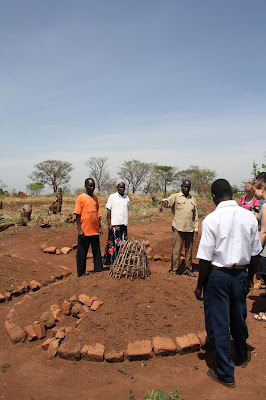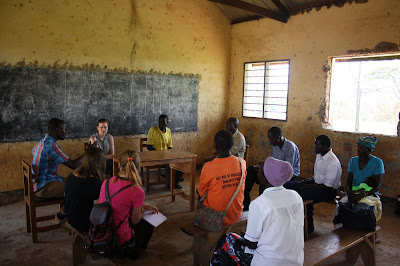One of our main findings during the fieldwork in Uganda was that people want to see the benefits of HWBF before they are willing to invest in the emptying equipment and composting tasks.
As a part of our concept scenarios would be to set up a demonstration garden which would benefit both the school and the community members. We initially learnt about this from African Revival, an NGO which has set up school demonstration gardens (SDG) in Uganda. We visited one of those in Lujoro primary school.
It was very interesting to meet the parents and hear their thoughts on the project that started a year ago. The gardening is purely organic therefore they have implemented different techniques to apply organic fertilisers. For example we saw "a surface runoff fertiliser" where compostable waste together with chicken and goat dung is added in a twig basket on top of the soil. Rain then washes the nutrients down to the plants. Their observation was that this type of plot was more fertile and had better yield than the traditional plots.
 |
| How the organic fertiliser was applied on the SDG in Lujoro p/s. |
The good results of the SDG has lead the participants to replicate those practises at their household gardens. Also other people in the community have heard of the good yields and have been interested in learning their practises. Also the first yields of the garden were promising. The profits of the group are divided up into three sections at the end of each year. 30 % goes directly to the school for the Head Teacher, school management, teachers and the PTA to decide what to spend the money on. Often it is for put towards building new latrines or buying new furniture for the school. 30 % goes back into the SDG group account so that the garden can keep going the following year, with savings to buy more seeds for example. Finally, the remaining 40 % is divided up between the group members, depending on their attendance at the garden throughout the year. The members pay a joining fee in the beginning which is used to buy tools and seeds for example. At the moment in Lujoro SDG had 65 members.
Though African Revival was the initiator for the SDG the members have the ownership of the project. African Revival organised training events in the beginning and now has some regulatory visits to the site approximately once a month but the main tasks are distributed amongst the members. One important aspects of the SDG is to bring the parents closer to the school and thus enhance the school-community relationship.
All the information we gathered during our visit to Lujoro were fascinating and we will use these learnings in designing of our concept.
If you want to read more about the African Revival School Demonstration Gardens please visit their website.
 |
| Having a fruitful discussion with the members of the SDG. |
Photos by: Anne Hyvärinen
Ei kommentteja:
Lähetä kommentti